Loy Stewart
-
- INSIGHTS: Loy Stewart, Jr. Marine News, Sep 2019 #14
Loy Stewart, Jr. is President, Detyens Shipyards. He is a 1991 graduate of the US Merchant Marine Academy in Kings Point where he earned a degree in Marine Engineering. After several months sailing on the Sealift Atlantic, Loy began working at Detyens as a Ship Superintendent and coordinated work on numerous commercial and navy contracts. In 1996, when the Detyens Shipyards were divided into separate profit centers, Loy Jr. was promoted to Profit Center Manager of the Wando facility. In 2002 he was made PCM of the Main Yard in North Charleston and promoted to Executive Vice President in 2003. On October 1, 2004 Loy became the company president and in 2010, he and his two younger brothers purchased Detyens Shipyards from their father becoming the third generation of family ownership. The road from the humble beginnings of the Detyens brand to its current position as a well-respected and prominent shipyard and repair facility has been anything but easy. Along the way, this Charleston, South Carolina-based business has built a tradition of quality workmanship at a reasonable price. Family owned and operated since its inception, the company has continually emphasized customer service, family values and safety in the workplace. Loy Stewart, Jr. lives the Detyens Creed – “Customer before Company, Employee before Owner, Family before Self, and Safety Above All” – every day. Listen in this month as he weighs in on the complicated and competitive world of ship repair.
One of the key strengths of your repair yard is its ability to cater to a wide range of sectors, including government, commercial, shallow draft and blue water tonnage. That kind of business mix can be challenging and widely diverse. Tell us about your equipment mix and the skills of the employees that combine to make it all come together.
Yes, we have been updating our equipment through the years. We have four drydocks; the largest being 755’ and all the necessary tools to carry out ship repair, but it is not our equipment that makes us such a diverse shipyard. It is our employees, their willingness to work hard and learn new technologies. We strive to keep all the work inside our facility so the shipowner and owner’s representatives can monitor every aspect of the ship overhaul. In a nutshell, we pride ourselves as being a one stop ship repair yard.
Location seems to be one of Detyens greatest strengths – among many others. But, being in the right place, positioned conveniently near the busy Caribbean, the northeast corridor and the Gulf Coast, vessels of opportunity have to be a big part of your business mix, yes?
Location is one of our strengths, but as I said before, our employees are our greatest strength. Charleston has always been a naturally deep harbor. Colonial settlers arrived in the 1670 and with continued Corp of Engineers support and the Port of Charleston’s initiatives to dredging the harbor and our channels do bring added advantages to our location. But, without employees, what good is our facility? A small portion of our yearly mix is emergency dockings, but those are fewer and far between the regulatory and planned dockings that we currently have on the books. We can’t just sit back and wait for that ‘opportunity’ vessel; we aggressively bid projects to fill our pipeline with work for the weeks, months and quarters ahead.
In keeping with the Detyens creed of ‘Customer before Company,’ your firm strives to deliver on-time, excellent service. A ship in the yard is not making its owner money. You’ve also said that you aren’t looking to make the short term profit; you want to make money now, of course, but it is the long term relationship that you aspire to. Tell us a bit about how you actually make that happen.
All of our employees realize that our customers are the most important people at the shipyard. If not for customers, why would we need employees? The employees understand that the ship makes no money for its owner while it is at the yard and we have created a bonus plan that incentivizes the employees to treat the customer with respect, do a quality job and get the ship out in time. Actually, repeat customers normally ask for certain workers before they even arrive. Our bonus structure rewards the employees with a percentage of the gross receipts of the project whether the company made or lost money as long as the vessel left on time and the owner was happy. Last year they received over 6 weeks of pay in their bonus checks.
Also in keeping with the Detyens corporate philosophy of caring for ‘the employee before owner,’ you also share the business rewards with employees, families and the local community. That all sounds good. How does it work in real practice? Give us some real life examples of that policy in play.The hourly employee bonus pool is based on customer satisfaction and not profit. All our employees get their health care coverage for free and we offer an onsite medical facility for the employees and their families free of charge. There is a small cost for full family health care coverage at a nominal fee, but the medical center visits and the prescription medicines are free of charge. We also house and support The Harvest Free Medical Center. Harvest Free is a free medical clinic that supports those less fortunate in pour population that don’t have affordable health care. Detyens is also involved in ALS research in hope of finding a cure for this terrible disease.
You pride yourself on running ne of the most successful ship repair businesses in the U.S., a privately owned operation focused on what it knows best: ship repair. Any thoughts to bidding for new builds in the future? You’ve certainly got the real estate; the lay down space and the equipment. Why or why not?
Yes, we have a big facility and back when the Navy occupied the yard, they did build ships here; however, a new build yard and a repair yard are like night and day. We took up the position 25 years ago that we were going to become the best commercial ship repair in the country and we are going to stay the course.
Last fall, you said that you’d be moving the hull and pipe shop into bigger buildings. The move was said to be aimed at attracting even larger jobs, and to situate the company to grow for another 50 years. How’s that move going, is it complete and has it yielded the premium assignments you’ve envisioned?
The move has gone as planned and we are happy with the outcome. Everyone always asks, “How are you going to grow, how can you get bigger?” Well, we have four drydocks, eight deep water piers, hundreds of thousands of usable square feet of inside workshops and machining centers, but there are only so many hours in a day and days in a year. Our growth opportunities for the immediate future come with improved efficiencies.
What kind of foreign flag work do you typically perform? Do these tend to be ‘vessel of opportunity’ emergency dockings, etc., or are their clients that plan months in advance for work?
Give us a sense of how that work evolves. Typically, the foreign flag work is container vessels trading in the Caribbean area, as well as offshore oil vessels transiting from the North Sea and West Africa regions into the US Gulf. These projects are brought to us through our worldwide agent network. The past several years has seen a slowdown due to the oil patch work drying up and the week EURO. We have also seen increased competition for those vessels in the Caribbean area and the vessel owners are able to reposition those vessel to Asia for much cheaper alternatives when it comes to regulatory dockings. We do get 3 to 5 foreign flag vessels annually that need emergency or unexpected repairs. Those types of projects are quick and painless for our workers, importantly, for the vessel owners and operators.
At one time, 90% of your business was government work, but as the Navy transitioned elsewhere, you also saw your work mix move more to the commercial side of the equation. But, you still do a lot of government work, don’t you? What’s the key difference between government repair work and the commercial jobs?
Yes, back in the day, we did a lot of Navy work, but when the Navy left Charleston, so did our largest customer base. We had to change with the tide so to speak and revert to doing more and more commercial work. Over time, we became less practiced in doing Naval “NAVSEA” vessels and more accustomed to commercial ”Auxiliary USNS/MARAD/MSC” vessels. However; we see changes ahead coming for all government sector vessels; including but not limited to U.S. Coast Guard vessels, NOAA assets, auxiliary fleet and/or Naval Combatants Ships. One thing is for certain, change is constant and if we are to stay relevant in the domestic ship repair business for the next 50 years, we have to makes changes to the way we do business in order to accommodate our customers’ requirements. And we have, and we will continue to do so, as needed.This article first appeared in the September print edition of MarineNews magazine.
-
- Repair Yard Detyens Taps into Key Niche Markets Marine News, Nov 2016 #60
yard. In 1982, William J. Detyens sold the business to a small group of employees which included his son-in-law and the yard’s current owner, D. Loy Stewart. In those days, U.S. Navy and Government work provided the majority of its business, but in 1993, the Charleston area was dealt a major blow when
-
- Shipyard Report: Detyens Shipyards Maritime Reporter, Nov 2018 #70
In a world driven by the dollar sign, D. Loy Stewart, Jr., owner and president of Detyens Shipyards missed the memo. Make no mistake, Stewart is steadfast to deliver on-time, excellent service to Detyens’ broad array of ship repair clients, from government to commercial, both foreign and domestic. He
-
- Detyens Concludes Largest U.S. Conversion Maritime Reporter, Aug 2001 #32
of ship repair we knew that we would have to start with small commercial repair jobs and work our way up to the larger, more complex jobs," said Loy Stewart, president, Detyens Shipyard. The renewed ship is on charter from Argent Marine Services to Shell Bermuda Overseas, Ltd. The Galleoma job
-
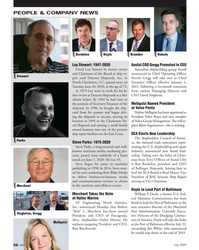 )
July 2020 - Marine News page: 56
)
July 2020 - Marine News page: 56PEOPLE & COMPANY NEWS DoyleBrandes Bordelon Rekola Loy Stewart: 1947-2020 Austal COO Gregg Promoted to CEO David Loy Stewart Sr, former owner Australian shipbuilding group Austal and Chairman of the Board at ship re- announced its Chief Operating Of?cer Stewart pair yard Detyens Shipyards, Inc. in
-
 )
September 2019 - Marine News page: 14
)
September 2019 - Marine News page: 14. That kind of business mix can be challeng- ing and widely diverse. Tell us about your equipment mix and the skills of the employees that combine to Loy Stewart, Jr. make it all come together. Yes, we have been updating our equipment through the President, years. We have four drydocks; the largest
-
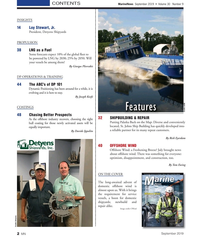 )
September 2019 - Marine News page: 2
)
September 2019 - Marine News page: 2CONTENTS MarineNews September 2019 • Volume 30 Number 9 INSIGHTS 14 Loy Stewart, Jr. President, Detyens Shipyards PROPULSION 38 LNG as a Fuel Some forecasts expect 10% of the global ? eet to be powered by LNG by 2030; 25% by 2050. Will your vessels be among them? By Giorgos Plevrakis DP
-
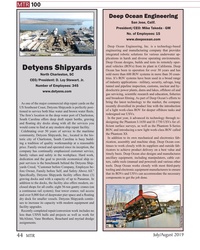 )
July 2019 - Marine Technology Reporter page: 44
)
July 2019 - Marine Technology Reporter page: 44sold more than 600 ROV systems in more than 30 coun- North Charleston, SC tries. It’s ROV systems have been used in a broad range CEO/President: D. Loy Stewart. Jr. of industry applications - military, security, salvage, long Number of Employees: 345 tunnel and pipeline inspection, customs, nuclear and
-
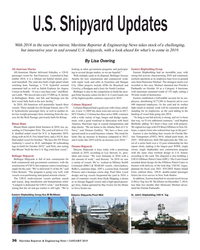 )
January 2019 - Maritime Reporter and Engineering News page: 36
)
January 2019 - Maritime Reporter and Engineering News page: 36wind farm vessel.” Detyens Shipyards is busy today with a promising owner, single shipbuilder new construction program outlook in 2019, according to Loy Stewart, Jr., pres- with the same class towboat design in U.S. history Bollinger Shipyards ident and owner. “We were fortunate in 2018 with a according
-
 )
November 2018 - Maritime Reporter and Engineering News page: 73
)
November 2018 - Maritime Reporter and Engineering News page: 73According to D. Loy Stewart, Jr. (left), when Detyens reached the deal to move its ship repair busi- “We went from the country fair to ness to the old Charleston Navy Shipyard, it was like Disney World, with the best facility that taxpayer dollars could build.” delivered the week of Thanksgiving.
-
 )
November 2018 - Maritime Reporter and Engineering News page: 71
)
November 2018 - Maritime Reporter and Engineering News page: 71the year and ters – that stand as a testament to the shipyards’ long-standing connection and commitment to its local community. Its owner, D. Loy Stewart, Jr. and his key staff are straight talking and genuine, con? rmed by the golf cart tour through the yard, stopping innumerable times as employees
-
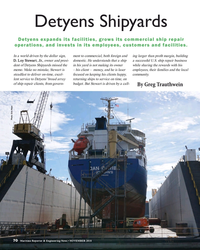 )
November 2018 - Maritime Reporter and Engineering News page: 70
)
November 2018 - Maritime Reporter and Engineering News page: 70, customers and facilities. In a world driven by the dollar sign, ment to commercial, both foreign and ing larger than pro? t margin, building D. Loy Stewart, Jr., owner and presi- domestic. He understands that a ship a successful U.S. ship repair business dent of Detyens Shipyards missed the in his
-
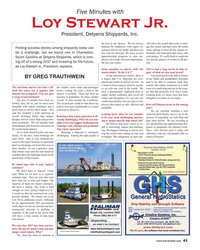 )
January 2018 - Maritime Reporter and Engineering News page: 41
)
January 2018 - Maritime Reporter and Engineering News page: 41Five Minutes with Loy Stewart Jr. President, Detyens Shipyards, Inc. the key to our success. We are always ci? c job is the people that come to man- looking for employees with repair ex- age the vessels and their crew. We really Finding success stories among shipyards today can perience that ? t our
-
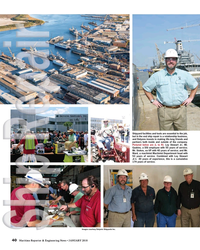 )
January 2018 - Maritime Reporter and Engineering News page: 40
)
January 2018 - Maritime Reporter and Engineering News page: 40business, and Detyens invests in making life-long friends and partners both inside and outside of the company. Pictured below are (L to R): Loy Stewart Jr.; Mr. Gaskins, a DSI employee with 55 years of service; Mr. Stokes, ex-VP with 40 years of service; and Mr. Ward, a machinist Machinist Department
-
 )
January 2017 - Maritime Reporter and Engineering News page: 43
)
January 2017 - Maritime Reporter and Engineering News page: 43know that they can go to Detyens and might pay a little bit more, but it will be fair and the boat is going to leave on time. No question.” D. Loy Stewart, Jr., President, Detyens This story is excerpted from a feature authored by Joseph Keefe for MarineNews, sister-publication to Maritime Reporter
-
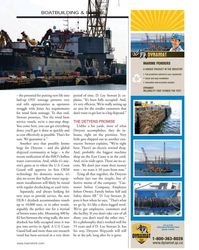 )
November 2016 - Marine News page: 65
)
November 2016 - Marine News page: 65BOATBUILDING & REPAIR – the potential for putting new life into period of time. D. Loy Stewart Jr. ex- laid-up OSV tonnage presents very plains, “It’s been fully occupied. And, real re? t opportunities as operators it’s very ef? cient. We’re really setting up struggle with Jones Act requirements an
-
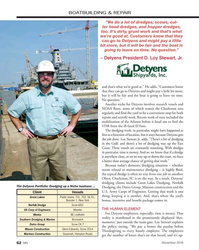 )
November 2016 - Marine News page: 62
)
November 2016 - Marine News page: 62go to Detyens and might pay a little bit more, but it will be fair and the boat is going to leave on time. No question.” – Detyens President D. Loy Stewart, Jr. and that’s what we’re good at.” He adds, “Customers know that they can go to Detyens and might pay a little bit more, but it will be fair
-
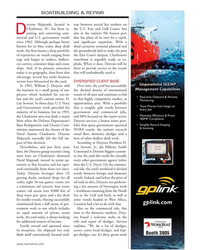 )
November 2016 - Marine News page: 61
)
November 2016 - Marine News page: 61which included his son-in- vessels of all sizes and continues to bid law and the yard’s current owner, D. in that highly competitive market, as Loy Stewart. In those days, U.S. Navy opportunities arise. With a portfolio and Government work provided the that is roughly split evenly between majority
